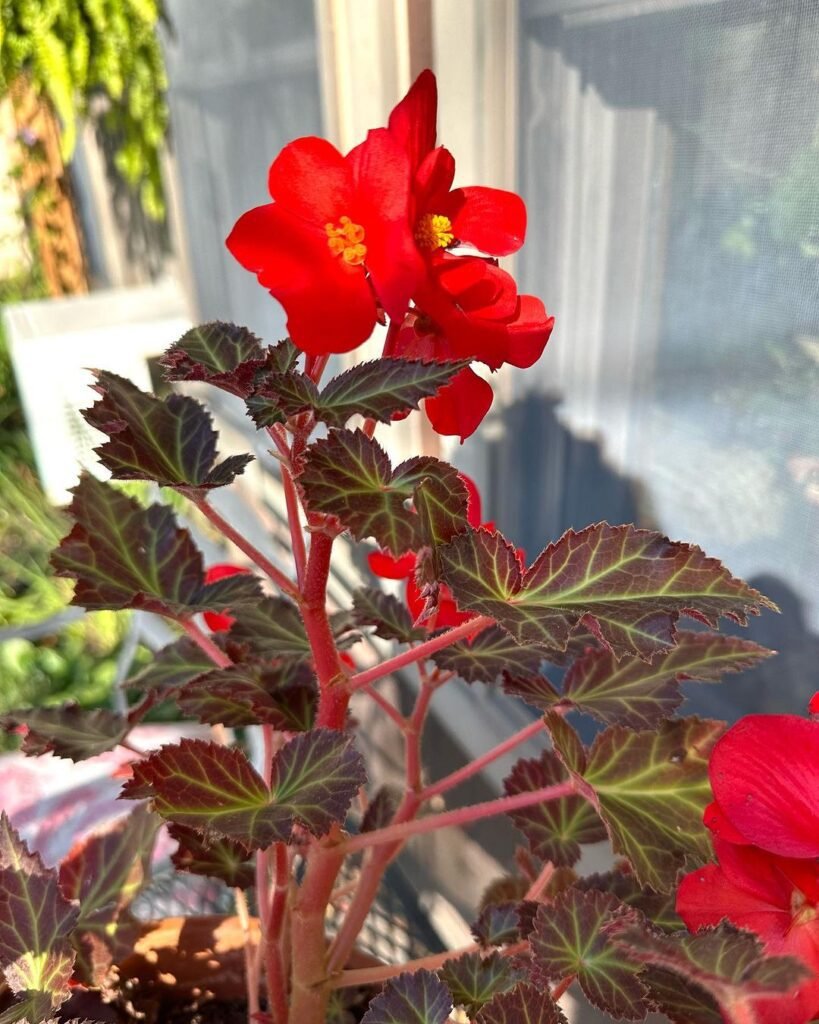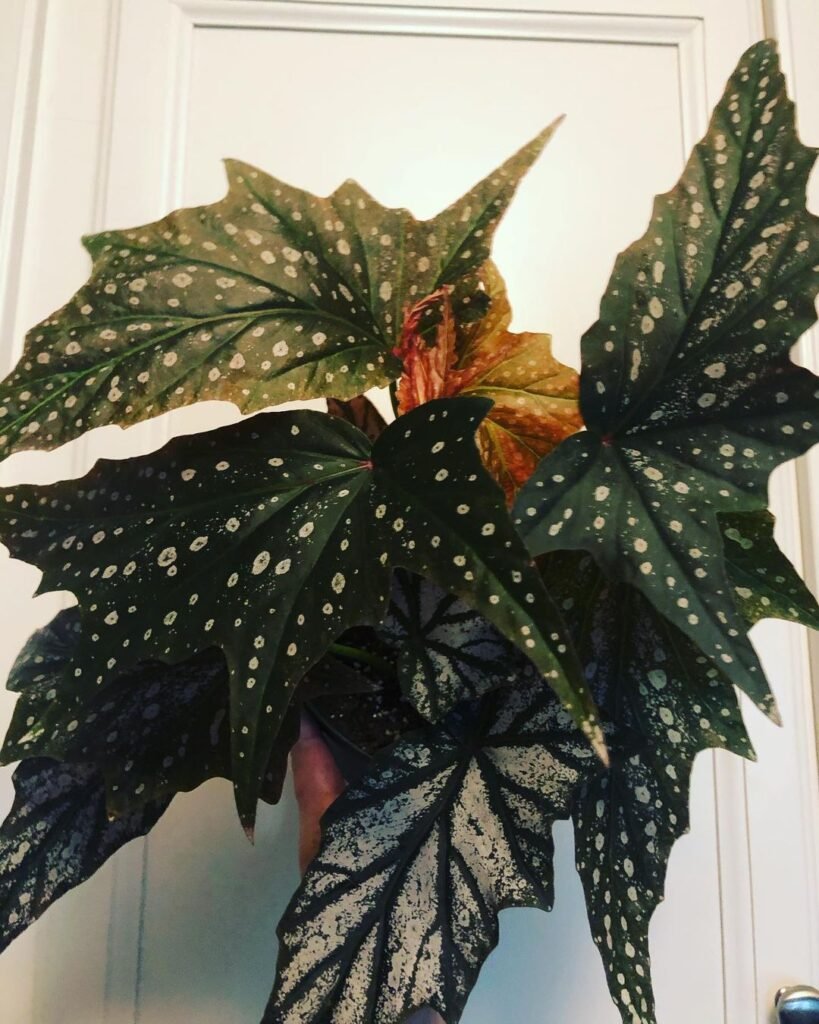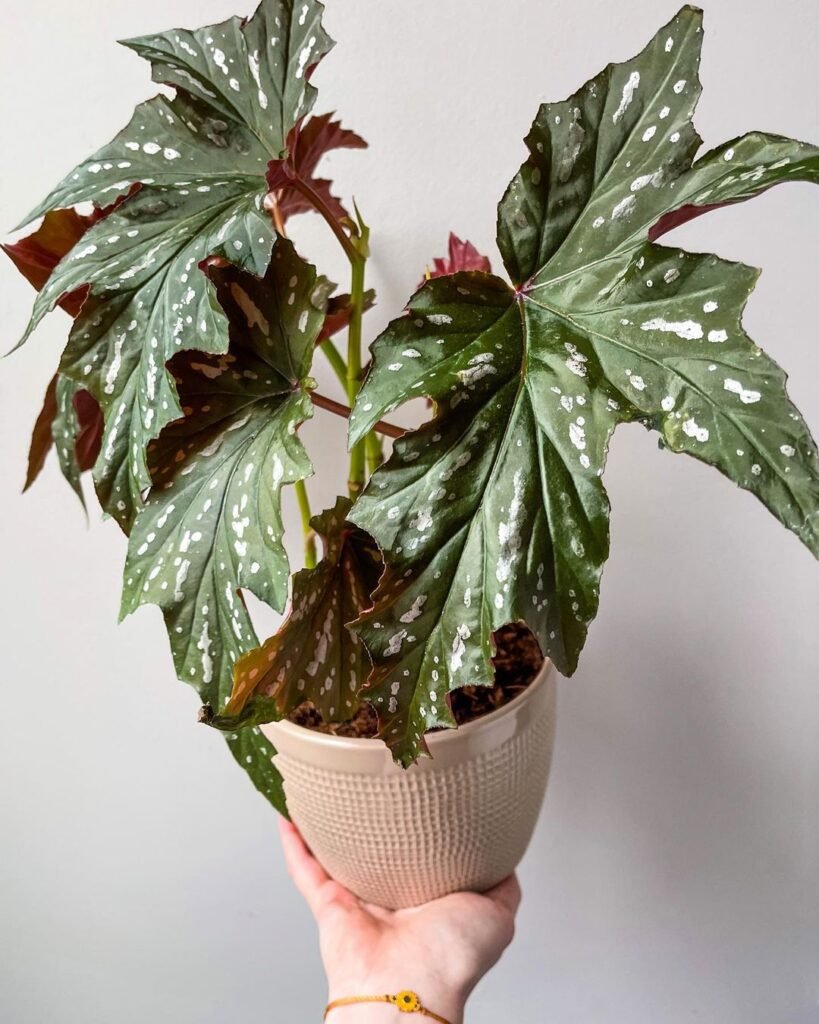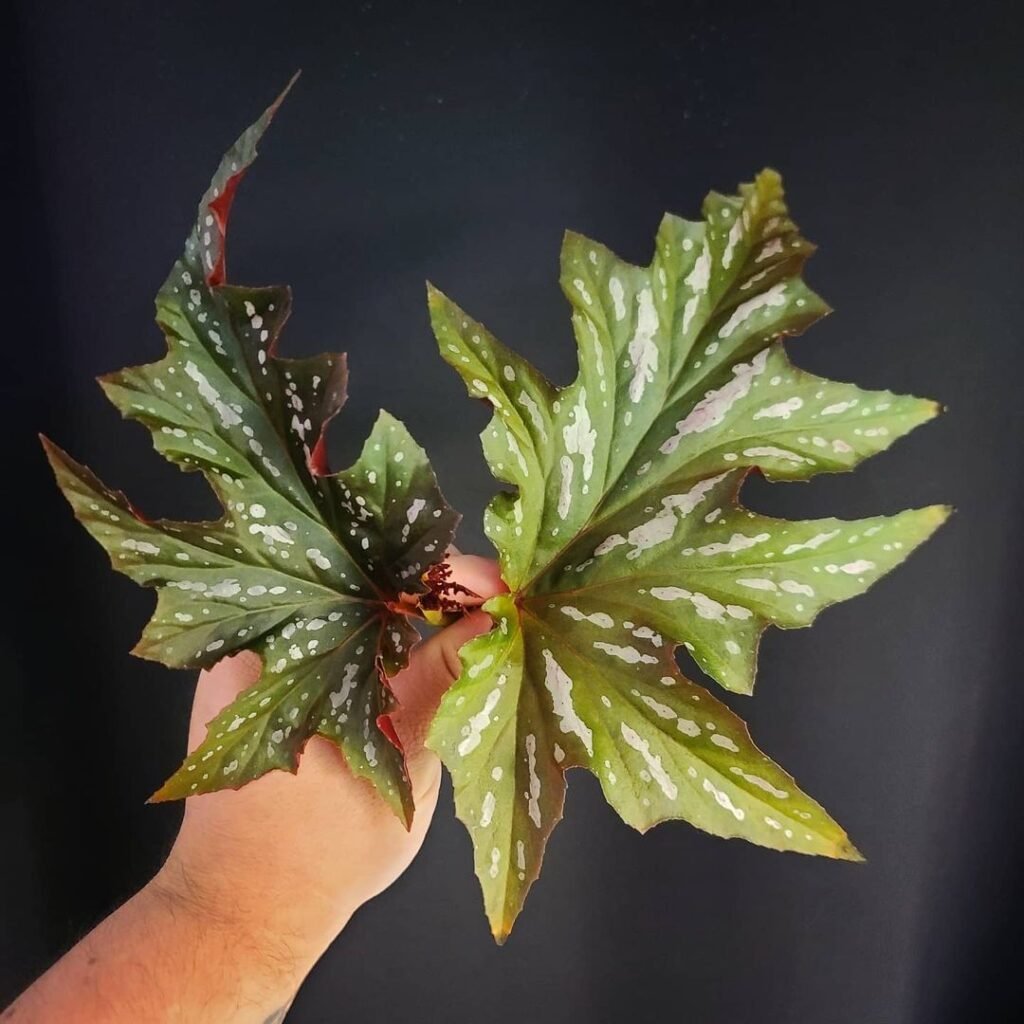Embark on a journey into the captivating realm of the Bat Wing Begonia, where botanical fascination takes flight. Having nurtured these extraordinary plants for some time, I’ve come to appreciate the allure of their unique bat-like wings.
Join me as we explore the enchanting world of Bat Wing Begonias, as I guide you through their care and cultivation.
Key Takeaways
- Distinctive Appearance: The Bat Wing Begonia derives its name from the captivating shape of its leaves, resembling the wings of bats in mid-flight.
- Varied Colors: From rich greens to shimmering silvers, the Begonia showcases a spectrum of colors, bringing vibrancy to any indoor space.
- Low Maintenance Charm: Surprisingly easy to care for, the Bat Wing Begonia is an ideal choice for plant enthusiasts of all levels, offering beauty without the fuss.
- Thrives Indoors: Flourishing in indoor environments, this begonia adds a touch of the extraordinary to home decor, making it a charming companion for your living space.
- Unique Growth Patterns: Witness the graceful unfurling of begonia’s beguiling wings, creating a natural masterpiece that adds a touch of elegance to your plant collection.



Care Guide Overview
Before we dive into the nitty-gritty of Bat Wing Begonia care, let’s have a quick glance at the essentials. A successful care routine revolves around a harmonious balance of various factors, ensuring your begonia thrives in its unique habitat.
| Care Aspect | Care Description |
|---|---|
| 💧 Watering | Keep the soil consistently moist, avoiding waterlogged conditions. Allow the top inch to dry before the next watering. |
| 🌞 Lighting | Provide indirect light, avoiding harsh, direct sunlight. Begonias prefer a balance, thriving in bright, filtered conditions. |
| 🏡 Soil & Fertilizing | Use a well-draining potting mix. Fertilize during the growing season (spring and summer) with a balanced liquid fertilizer every 4-6 weeks. |
| 🌡️ Humidity & Temperature | Maintain a humidity level of around 50-60%. Keep the environment at a comfortable temperature range of 65-75°F (18-24°C). |
| ✂️ Pruning & Shaping | Trim leggy stems to encourage bushier growth. Regularly remove dead or yellowing leaves to maintain plant health. |
| 🌱 Propagation | Propagate through stem cuttings or by dividing the rhizomes. Ensure each cutting has a few leaves and a node for successful propagation. |
| 🌿 Repotting | Repot every 1-2 years or when the plant outgrows its container. Use fresh soil and check for any signs of rootbound growth. |
| 🌺 Seasonal Care | Adjust care routine based on seasons. Reduce watering in winter, and provide extra humidity during dry months. |
| 🌼 Companion Plants | Pair with other shade-loving plants like ferns or snake plants to create a visually appealing indoor garden. |
| 🦟 Pest Control | Keep an eye out for common pests like aphids or mealybugs. Address promptly with natural insecticides or insecticidal soap. |
| 🚑 Reviving Tips | If your begonia appears stressed, assess its care conditions. Adjust watering, lighting, or humidity accordingly to revive its vitality. |
Appearance of Bat Wing Begonia



The Bat Wing Begonia is a botanical masterpiece, captivating observers with its distinctive features. The most striking element is, of course, its leaves, which mimic the elegant wings of bats in mid-flight.
These unique leaves boast a velvety texture, with a slight iridescence that adds an extra layer of allure. The edges of the leaves are often adorned with delicate serrations, contributing to the begonia’s overall enchanting aesthetic.
Beyond its leaves, the plant’s stems exhibit a graceful arching habit, creating a visually pleasing cascade of foliage. The Begonia’s color palette is equally impressive, ranging from deep, luscious greens to silver hues, casting an ethereal glow.
Whether placed as a centerpiece or nestled among other botanical companions, the Bat Wing Begonia is sure to command attention and admiration, making it a standout addition to any plant collection.
Not the plant for you? Check out my full list of 78 Types of Begonia!
How to Grow Bat Wing Begonia
Cultivating a thriving Bat Wing Begonia involves a delicate dance of providing the right conditions. Let’s explore the key elements of growth, from the basics to the nuanced care that ensures your begonia spreads its captivating wings.
💧 Watering
Proper watering is paramount to the Bat Wing Begonia’s well-being. Aim for soil that is consistently moist, not soggy. When the top inch of the soil feels dry to the touch, it’s time to water. Remember, overwatering can lead to root rot, so find that sweet spot by observing your plant’s specific needs.
Care Tip: Consider using a saucer beneath the pot to catch excess water, preventing root saturation.
🌞 Lighting
Lighting plays a crucial role in the begonia’s growth. Provide indirect light to mimic its natural habitat under the canopy of larger plants. Avoid harsh, direct sunlight, as it can scorch the delicate leaves. Strive for a balance, ensuring your Begonia receives bright, filtered light for optimal development.
Care Tip: Rotate your plant periodically to ensure all sides receive adequate light, promoting even growth.
🏡 Soil and Fertilizing
Selecting the right soil is fundamental. Opt for a well-draining potting mix to prevent waterlogged conditions. During the growing season (spring and summer), feed your Begonia with a balanced liquid fertilizer every 4-6 weeks. This provides essential nutrients for robust growth.
Care Tip: Dilute the fertilizer to half strength to prevent overfeeding, which can lead to nutrient burn.
🌡️ Humidity and Temperature
Maintaining the right humidity and temperature is key to a happy Begonia. Aim for a humidity level of around 50-60%, creating a tropical atmosphere. Keep the environment at a comfortable temperature range of 65-75°F (18-24°C), avoiding extremes.
Care Tip: Grouping plants together can naturally increase humidity levels, creating an ideal microclimate.
✂️ Pruning and Shaping Tips



Maintaining the alluring form of your Bat Wing Begonia involves strategic pruning and shaping. Mastering these techniques not only enhances the plant’s aesthetic appeal but also promotes healthier growth.
Assessing Leggy Growth
Begin by evaluating your begonia for any leggy stems—those that have elongated with sparse foliage. These stems often indicate a need for pruning to encourage bushier growth. Identify areas where pruning can stimulate new shoots and enhance the overall fullness of the plant.
Selective Pruning Techniques
- Pinching: Gently pinch off the tips of leggy stems using your fingertips. This encourages branching and promotes a more compact, bushy appearance.
- Crown Pruning: Trim the upper part of the plant to stimulate lateral growth. Focus on areas where you want the begonia to fill out, creating a well-proportioned silhouette.
Shaping for Aesthetic Appeal
- Arching Stems: Emphasize the natural arching habit of the stems by pruning to accentuate this graceful characteristic.
- Leaf Arrangement: Pay attention to the arrangement of leaves and prune to maintain a balanced distribution, avoiding overcrowding.
| Pruning Tool | Purpose |
|---|---|
| Pruning Shears | Precision cutting for targeted pruning. |
| Fingertips | Gentle pinching for delicate adjustments. |
🌱 Propagation Tips
Expanding your collection of Bat Wing Begonias or sharing the joy with fellow plant enthusiasts is a rewarding endeavor. Explore various propagation methods to propagate your begonia successfully.
Stem Cuttings
- Select Healthy Stems: Choose stems with several healthy leaves and a node (the point where a leaf meets the stem).
- Trimming: Use sharp, clean scissors to cut a 4-6 inch section just below a leaf node.
- Rooting Medium: Plant the cutting in a well-draining rooting medium, ensuring the node is below the soil surface.
- Moisture and Humidity: Keep the soil consistently moist and maintain higher humidity levels to encourage root development.
Division of Rhizomes
- Lift the Plant: When repotting, carefully lift the Begonia from its container.
- Separate Rhizomes: Identify sections of the rhizome that have both roots and stems, and gently separate them.
- Plant Separated Sections: Plant each separated section in its own pot with fresh soil.
- Watering: Water thoroughly after planting and maintain regular care to support the newly divided plants.
By mastering these techniques, you can sculpt and propagate your Bat Wing Begonia with precision and confidence.
🌿 Repotting Tips



Repotting your Bat Wing Begonia is a task that goes beyond simply changing its residence—it’s an opportunity to revitalize and invigorate its growth. Follow these specialized tips to ensure a smooth transition for your botanical companion.
Signs It’s Time to Repot
- Rootbound Appearance: If you notice the roots circling the pot or growing out of the drainage holes, it’s a clear sign that your Begonia is outgrowing its current home.
- Decreased Growth: A stagnation in growth or the appearance of stunted leaves could indicate that the plant has exhausted the nutrients in its current soil.
Specialized Repotting Techniques
- Rhizome Inspection: During repotting, inspect the rhizomes for signs of rot or damage. Trim any unhealthy portions to encourage new, healthy growth.
- Gentle Handling: Begonias can be sensitive during the repotting process. Handle the plant gently to minimize stress and shock.
- Fresh Soil: Use a well-draining potting mix with added perlite or orchid bark for optimal aeration. This ensures the roots have access to both nutrients and oxygen.
- Correct Pot Size: Choose a pot that allows for a bit of room for growth but isn’t excessively large. A snug fit encourages the development of a robust root system.
| Signs It’s Time to Repot | Specialized Techniques |
|---|---|
| – Rootbound appearance | – Rhizome inspection for rot or damage |
| – Decreased growth | – Gentle handling to minimize stress |
| Specialized Techniques | Fresh Soil & Pot Size |
|---|---|
| – Rhizome inspection for rot or damage | – Use well-draining mix with perlite or orchid bark |
| – Gentle handling to minimize stress | – Choose a pot that allows room for growth |
🌺 Seasonal Care
Understanding the nuanced needs of your Bat Wing Begonia throughout the seasons is the key to sustaining its health and vitality. Let’s explore tailored care tips to ensure your plant thrives year-round.
Spring Awakening
- Increased Fertilization: As the growing season begins, boost your fertilization routine to support the begonia’s heightened energy requirements.
- Regular Pruning: Encourage a burst of new growth by engaging in selective pruning, removing any winter-damaged or leggy stems.
Summer Splendor
- Hydration Emphasis: With higher temperatures, pay extra attention to watering to prevent soil from drying out. However, maintain the balance to avoid overwatering.
- Shade Protection: Shield your Begonia from intense midday sun to prevent leaf scorching. Consider moving it to a spot with filtered light during the hottest hours.
| Spring Awakening | Summer Splendor |
|---|---|
| – Increased Fertilization | – Hydration Emphasis |
| – Regular Pruning | – Shade Protection |
By aligning your care routine with the changing seasons, you provide your Bat Wing Begonia with the tailored support it needs, ensuring it remains a flourishing focal point in your botanical haven.
🌼 Companion Plants
Creating a harmonious plant community is an art form, and choosing the right companions for your Bat Wing Begonia can elevate the visual appeal of your indoor garden. Consider these companion plants to complement the begonia’s unique charm.
- Ferns: The delicate fronds of ferns create a lovely contrast to the bold foliage of the Begonia, adding a touch of elegance to the display.
- Snake Plant (Sansevieria): With its upright, architectural leaves, the Snake Plant serves as an excellent backdrop, allowing the Bat Wing Begonia to shine as the focal point.
- Calathea: The intricate patterns on the leaves of Calathea plants add visual interest and diversity to your plant arrangement.
Remember, when selecting companions, consider factors like light and water requirements to ensure a harmonious coexistence.
If you’re thinking of extending your begonia family, I recommend considering either jurassic begonia or begonia aconitifolia. They both would make great additions to your squad!
🦟 Pest Control Tips
While the Bat Wing Begonia is generally hardy, occasional encounters with pests may occur. Vigilance and prompt action are the keys to maintaining a pest-free environment for your plant. Here are targeted pest control tips for common intruders:
Aphids
- Soapy Solution: Mix a mild solution of soapy water and spray it on affected areas. The soap disrupts the aphids’ protective coatings, rendering them vulnerable.
- Neem Oil: Apply neem oil to deter aphids. Its natural properties act as a repellent and disrupt the pests’ feeding patterns.
Mealybugs
- Isopropyl Alcohol: Dab a cotton swab soaked in isopropyl alcohol onto mealybugs. This dehydrates and eliminates them without harming the plant.
- Insecticidal Soap: Utilize insecticidal soap, specifically formulated to target mealybugs. Follow the instructions on the product for effective control.
Preventive Measures
- Regular Inspections: Routinely check your Begonia for early signs of pest infestations, such as discolored or distorted leaves.
- Isolation: If an infestation is detected, isolate the affected plant to prevent the pests from spreading to other plants.
By incorporating these targeted pest control measures into your care routine, you can ensure that your Bat Wing Begonia remains resilient and pest-resistant.
🚑 Reviving a Sick or Wilting Bat Wing Begonia
Witnessing your Bat Wing Begonia in distress can be disheartening, but with the right intervention, you can revive its vitality. Follow these steps to nurse your plant back to health:
- Assess Care Conditions: Evaluate factors like lighting, watering, and humidity to identify any deviations from the plant’s preferred conditions.
- Adjust Watering: If the soil is consistently wet, reduce watering frequency. Conversely, if the soil is dry, increase watering to restore moisture levels.
- Inspect Roots: If root rot is suspected, gently remove the plant from its pot and inspect the roots. Trim any mushy or discolored roots and repot in fresh soil.
- Pruning for Recovery: Trim away any diseased or yellowing leaves to redirect the plant’s energy towards new, healthy growth.
- Isolate the Plant: If a specific issue is identified, isolate the Begonia to prevent the spread of diseases or pests to other plants.
Remember, patience is key when nursing a sick plant back to health. With consistent care and attention, your Bat Wing Begonia can bounce back, showcasing its resilience.
📝 Conclusion
The journey of cultivating and caring for a Bat Wing Begonia is a delightful exploration of botanical beauty and horticultural finesse. From its captivating appearance to the intricacies of seasonal care, each aspect contributes to the overall charm of this remarkable plant. Remember, the journey of caring for your Begonia is not just about keeping it alive; it’s about creating an environment where it can thrive, flourish, and showcase its unique beauty.
🚀 FAQ
How often should I water my Bat Wing Begonia?
The watering frequency for your Bat Wing Begonia depends on various factors, including the temperature, humidity, and the specific conditions of your home. Generally, water when the top inch of the soil feels dry to the touch, ensuring that the soil remains consistently moist but not waterlogged.
What type of soil is best for Bat Wing Begonia?
A well-draining potting mix with added perlite or orchid bark works best for Bat Wing Begonia. This helps prevent waterlogged conditions and ensures the roots have access to both nutrients and oxygen.
Can I propagate my Bat Wing Begonia in water?
Yes, you can propagate Bat Wing Begonia from stem cuttings in water. Ensure the cutting has a few leaves and a node, place it in water, and wait for roots to develop before transferring it to soil.
How do I revive a wilting Bat Wing Begonia?
To revive a wilting Begonia, assess its care conditions, adjust watering, inspect the roots for signs of rot, prune away diseased leaves, and consider isolating the plant if necessary. Patience and consistent care are crucial for successful revival.
Can Bat Wing Begonia tolerate direct sunlight?
Bat Wing Begonia prefers indirect light and can be sensitive to harsh, direct sunlight, which may scorch its delicate leaves. It thrives in bright, filtered light conditions.

Writer/Green Thumb/Explorer – Rooted deep in the rich soils of Devon, I’ve cultivated a vast expertise in plant care, helping greenery thrive in homes across the UK. When I’m not crafting detailed plant care guides, I’m journeying through the lush landscapes of the West Country, unearthing nature’s secrets and sharing them with fellow plant enthusiasts. Every leaf has a story, and I’m here to tell it.





